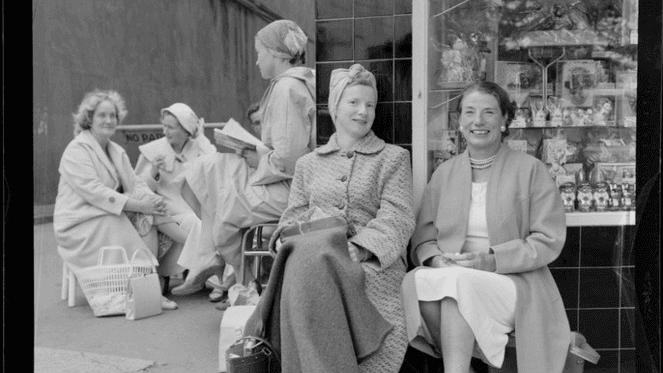Queuing comes naturally to New Zealanders. Our love affair with orderly lines outside cafes, ticket booths, and at the Bunnings’ sausage sizzle speaks to our penchant for fairness. With these lines appearing at our supermarkets under lockdown, let’s understand more about this custom and look back on queues through Wellington’s history for inspiration to continue with this patriotic pastime.
Academic minds have spent time researching queues and what drives us to form them. Milgram et al. (1986) state that the collective act of queuing provides individuals with a recognisable social structure that is distinct from the crowd, which they then apply towards a purpose, such as purchasing tickets at a booth. This social structure includes norms and punitive measures for those who dare to challenge it. They explain that a queue depends on shared knowledge of the acceptable behaviour to operate and to police challenges.
In a description of queues at football matches in Australia, Mann (1969) provides an interesting ‘Profile of the Queuer’ from the mid-20th Century:
“The typical queuer is male, not yet twenty-five years of age, lives in a working-class suburb, and probably has absented himself from work to wait in line. Together with three friends, he has waited for at least fifteen hours to get tickets to watch his club play in the finals. He cannot explain why he likes football, but he has followed his team faithfully since childhood. He claims he would still be queuing even if his team were not playing, but the scarcity of supporters of nonfinals teams in the queue indicates that this is not likely. He has not counted the number of people ahead of him and has no real idea of the number of tickets for sale to the queue. He is fairly confident that he will get tickets, and he does not seem very unhappy about the queue system.”
Allon and Hanany (2012) characterise queues as a tool for “economic maximization” as they benefit the customer and the manager by producing procedural efficiencies. Those in the queue are aware of this trait and pitch an internal battle between their rational reasoning and their self-interest to queue-jump, which may risk their position in the line and the whole structure’s operation.
Let’s now look at Wellington’s queues through history:
Women queue for Ballet tickets at Opera House, Wellington. 9 March 1959.

View of unidentified people, in a queue for ‘20 year’ rugby tickets, costing £100, Wellington. 2 May 1960.
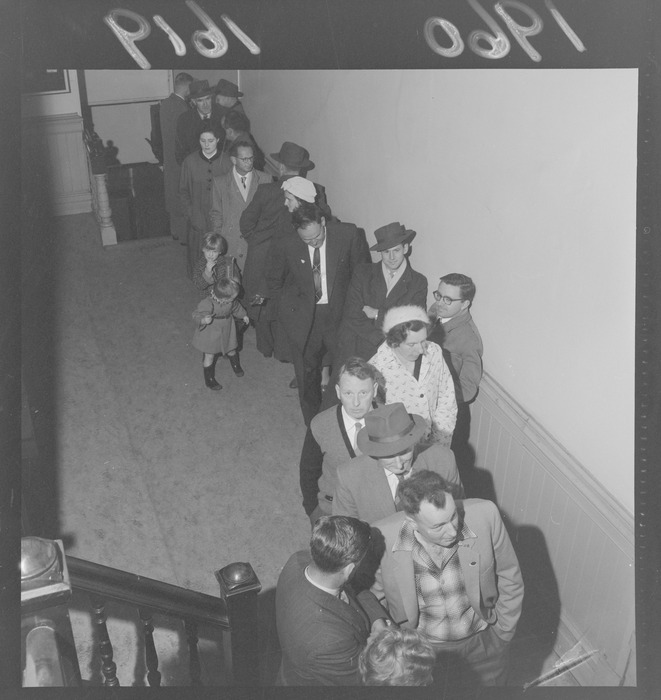
Queue of people lining up for a fire sale at McKenzie’s department store, Wellington. 11 May 1959.
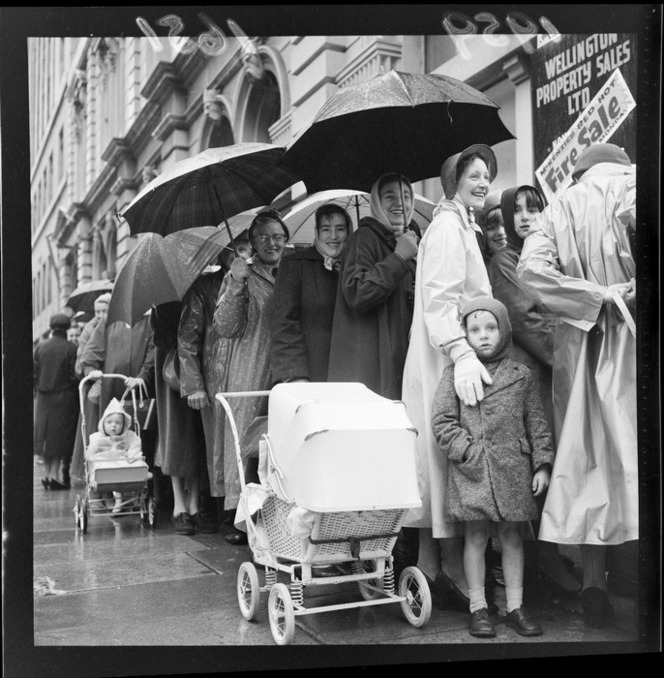
Crowd queuing to go inside house that is part of the Tawa ‘Parade of Homes’, Wellington. 6 April 1959.
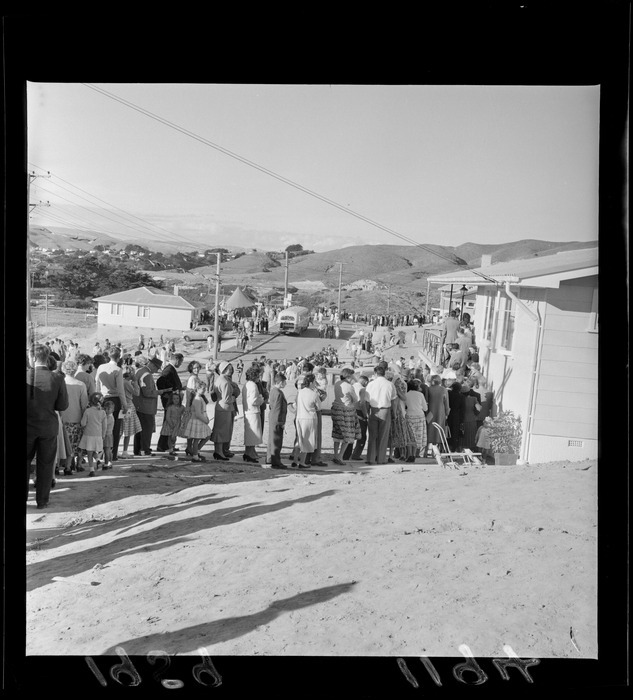
Cars queued up along Branda Pass waiting for a tsunami, Wellington. 27 May 1960.
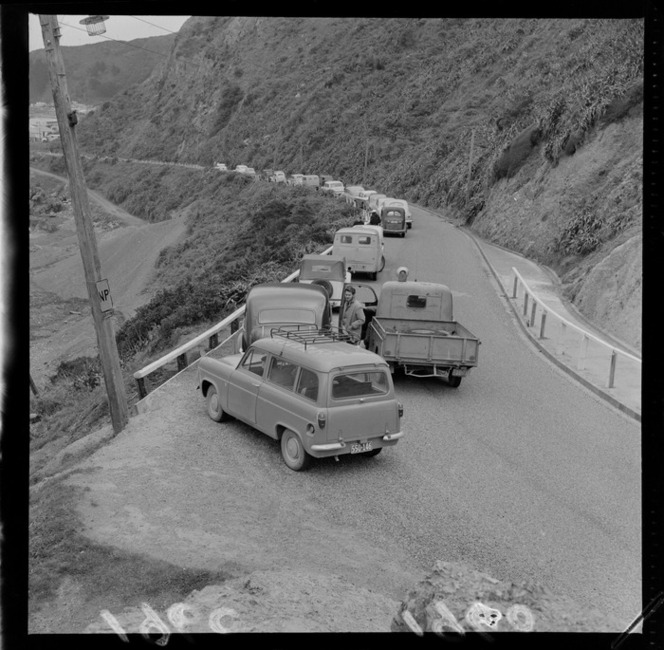
Crowd waiting in a queue next to each counter to register their motor vehicle. 1957.
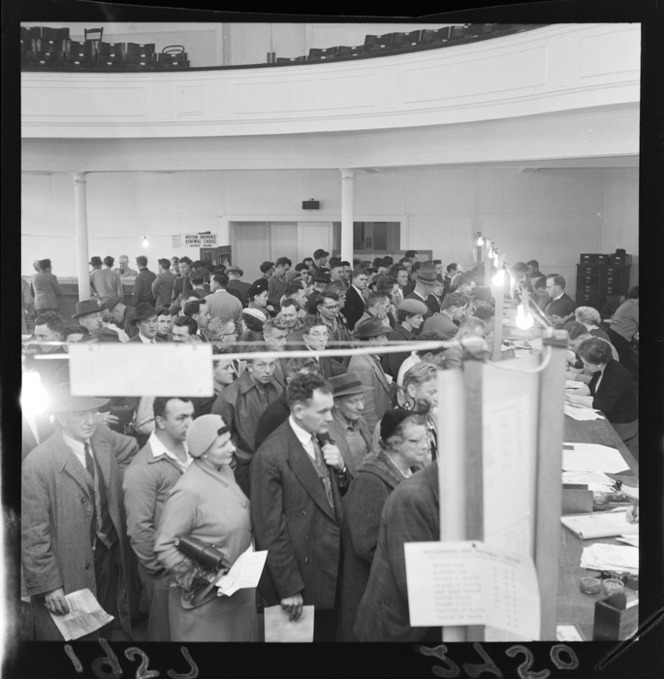
References
Allon, G., & Hanany, E. (2012). Cutting in Line: Social Norms in Queues. Management Science, 58(3), 493–506. https://doi.org/10.1287/mnsc.1110.1438
Cars queued up along Branda Pass waiting for a tsunami, Wellington. Dominion Post (Newspaper): Photographic negatives and prints of the Evening Post and Dominion newspapers. Ref: EP/1960/1940-F. Alexander Turnbull Library, Wellington, New Zealand. /records/30664742
Crowd queuing to go inside house that is part of the Tawa ‘Parade of Homes’, Wellington. Evening post (Newspaper. 1865-2002) :Photographic negatives and prints of the Evening Post newspaper. Ref: EP/1959/1194-F. Alexander Turnbull Library, Wellington, New Zealand. /records/23263251
Crowd waiting in a queue next to each counter to register their motor vehicle. Evening post (Newspaper. 1865-2002) :Photographic negatives and prints of the Evening Post newspaper. Ref: EP/1957/2750-F. Alexander Turnbull Library, Wellington, New Zealand. /records/23219831
Mann, L. (1969). Queue Culture: The Waiting Line as a Social System. American Journal of Sociology, 75(3), 340-354. Retrieved August 21, 2021, from http://www.jstor.org/stable/277569
Milgram, S., Liberty, H. J., Toledo, R., & Wackenhut, J. (1986). Response to intrusion into waiting lines. Journal of Personality and Social Psychology, 51(4), 683–689.
Queue of people lining up for a fire sale at McKenzie’s department store, Wellington. Evening post (Newspaper. 1865-2002) :Photographic negatives and prints of the Evening Post newspaper. Ref: EP/1959/1651-F. Alexander Turnbull Library, Wellington, New Zealand. /records/23503522
View of unidentified people, in a queue for ‘20 year’ rugby tickets, costing £100, Wellington. Dominion Post (Newspaper): Photographic negatives and prints of the Evening Post and Dominion newspapers. Ref: EP/1960/1619-F. Alexander Turnbull Library, Wellington, New Zealand. /records/30635378
Women queue for Ballet tickets at Opera House, Wellington. Evening post (Newspaper. 1865-2002) :Photographic negatives and prints of the Evening Post newspaper. Ref: EP/1959/0855-F. Alexander Turnbull Library, Wellington, New Zealand. /records/23261009
